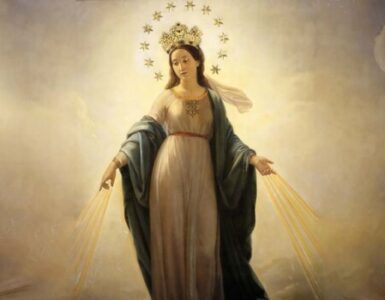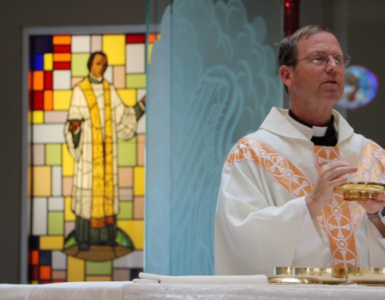Saint Elizabeth Ann Seton was born on August 28, 1774. She was the first native-born U.S. citizen to be canonized a saint by the Church. Elizabeth’s mother died three years after her birth and her childhood was far from stable. Her father remarried, but eventually separated from Elizabeth’s stepmother. The stepmother rejected Elizabeth and her sister. During the separation her father left for London and she was left in the care of her uncle. It was a difficult time for her as she came to terms with this abandonment. She was raised in the Episcopal Church and at 19 married William Magee Seton. They moved into their new residence on Wall Street and were well known members of New York society of the time. Even though she was abandoned by her stepmother, she had taught Elizabeth the value of social ministry. Elizabeth continued this service in married life. She nursed the sick and dying while also caring for her five children.
The death of her father-in-law and the uncertain economic times prior to the War of 1812 lead to a major decline in the family’s wealth. Conflicts between the U.S. and the French led to multiple blockades, as well as British blockades. There were major losses to Seton’s shipping company and he eventually had to file for bankruptcy. The stress of these events and the financial losses aggravated his chronic tuberculosis. Elizabeth, their eldest daughter, and William went to the warmer climate of Italy in an attempt to ease the symptoms. William died on December 27, 1803. Her late husband’s Italian business partners took her daughter and her in. It was through these connections that Elizabeth was introduced to Roman Catholicism.
Elizabeth returned to New York and was received into the Catholic Church on March 14, 1805 in the only Catholic Church in the region at the time. Anti-Catholic laws had only been lifted a few years prior. The following year she received the Sacrament of Confirmation by the only Bishop in the U.S., Right Reverend John Carroll of Baltimore.
Elizabeth’s economic situation continued to prove problematic. To provide for her children, she began a school for young girls. Unfortunately, many parents withdrew their children from the school after learning Elizabeth had converted to Catholicism. This anti-Catholicism almost resulted in her relocation to Canada as she struggled to support her family. She then met Abbe Louis William Valentine Dubourg, S.S. who was a Sulpician. His Order had fled France during the persecution of the French Revolution and was trying to establish a seminary on U.S. soil. He invited Elizabeth to join them.
After great difficulty Elizabeth moved to Emmitsburg, Maryland where the Sulpicians lived, in order to found a girls’ school. In 1810 she opened Saint Joseph’s Academy and Free School; thanks to the financial support of Samuel Sutherland Cooper who was a wealthy convert and seminarian at the new Mount Saint Mary’s University. Elizabeth then began a religious community dedicated to the service and care of poor children. It was the first congregation of religious sisters started in the United States and her school was the first free Catholic school in the U.S. It is here that the Catholic parochial school system began in the U.S. The congregation lived the rule established by St. Vincent de Paul for the Daughters of Charity in France and took the name Sisters of Charity of St. Joseph. Elizabeth became Mother Seton. Elizabeth spent her remaining days continuing to develop her new congregation of sisters. She died of tuberculosis on January 4, 1821. Her legacy continued after her death and schools started by her sisters could be found in Cincinnati and New Orleans by 1830. They also began the first hospital West of the Mississippi in St. Louis.
Elizabeth’s life was marked with grief, persecution, and economic hardship, but in the end, she persevered and completed what she set out to do. There is much to learn from her life and example.
Service
St. Elizabeth Ann Seton learned the value of service from the stepmother who abandoned her. She did not allow this pain to deter her in the mission of helping the poor. Elizabeth was a woman of culture who saw the great need of education, especially for poor girls. Her entire life was dedicated to this mission and serving the greater Glory of God. Her example is one for all of us in our call to give ourselves over to God that the world may be conformed to Him.
Suffering Persecution Patiently
The United States has a long history of persecuting Catholics. Elizabeth lived in a time of open and accepted persecution. She lost friends and students alike because of her conversion to Catholicism. Instead of giving up, she found a way to establish the schools she wanted to make available to poor girls. Her life is a reminder that regardless of the opposition, God will work through us to bring the good He desires in the world. Elizabeth submitted to God’s design for her life and did not stop until her mission was completed. She teaches us how to patiently bear the pain and suffering of persecution. Today people are being persecuted for their faith and we can turn to Elizabeth as an example of someone who persevered. She is also a great intercessor for the persecuted since she knows it all too well.
Forgiveness
We are Fallen and broken. We are capable of causing great pain in others and experiencing deep hurt from other people. Elizabeth lost her birth mother and was abandoned by her stepmother and father. Her adult life was marked by hardship and loss.
St. Elizabeth lost two children and her husband. She could have allowed all of this suffering the turn to bitterness, but instead she gave it back to God in service of Him. Elizabeth did not allow the pain of abandonment to warp her, but she instead harnessed it in service of those less fortunate. She took the lessons gleaned from her stepmother and lived them for the rest of her life. It is clear by her example that she was able to forgive those who abandoned her.
This weekend, January 4th, the Church celebrates the feast of Saint Elizabeth Ann Seton. Her life is a shining example for our own lives. She teaches us to follow Christ regardless of the opposition we face, grief and suffering we experience, and the abandonment by the ones we love. She kept her eyes firmly fixed on Christ, as we must. May she be a great friend and intercessor for us all.
Saint Elizabeth Ann Seton, ora pro nobis.
✠
image: By Nheyob (Own work) [CC BY-SA 3.0], via Wikimedia Commons














